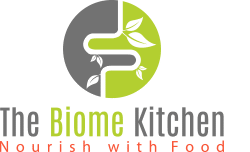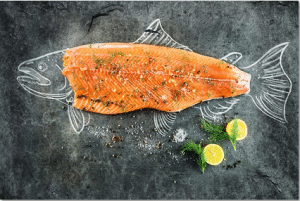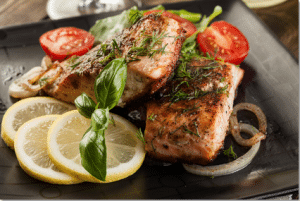Omega-3 Fatty Acids are a must for women and men in mid-life.
The two omega-3 fatty acids in fish, called eicosapentaenoic acid (EPA) and docosahexaenoic acid (DHA), are thought to guard against heart attack, stroke and sudden cardiac death. The benefits of DHA and EPA are also tied to a lower risk of Type 2 Diabetes, macular degeneration and Alzheimer’s disease. They also promote healthy eye and brain development in infants.
Farmed versus Wild Salmon:
In wild-caught salmon, omega-3s come from the algae, plankton and smaller fish (e.g. herring) in their diet. Species of wild salmon include Chinook, Sockeye (red), Coho, Pink and Chum. Chinook, Chum and Coho Salmon may also be farmed.
The vast majority of farmed salmon (over 90 per cent) are Atlantic salmon, which are hatched, raised and harvested under controlled conditions. The omega-3 fat content of farm-raised salmon depends on the type of feed they eat, which consists of a combination of plants, grains, fishmeal and fish oil.
Farmed Salmon Has More Omega-3s:
Three ounces of Atlantic salmon has 175 calories, 10.5 grams of fat and 1,820 milligrams of DHA plus EPA. The same serving size of sockeye salmon contains 133 calories, 4.7 grams of fat and 730 milligrams of omega-3s.
It’s also packed with protein, B vitamins (especially B12), selenium and potassium. Salmon is one of the few foods naturally high in vitamin D, delivering 350 to 715 international units (IU) per three ounces. (Health Canada recommends 600 IU per day for children aged one to adults aged 70, and 800 IU daily for adults older than 70.)
Bottom Line:
“Farmed Atlantic salmon, it turns out, outranks wild Pacific salmon, with 20 per cent to 70 per cent more omega-3 fat per serving.”
Fishing for Facts
Research suggests healthy adults consume at least 250 to 500 milligrams of omega-3 fatty acids (DHA + EPA) a day to guard against coronary heart disease. Omega-3 fats store in the body, so you don’t have to eat them every day to reach this target intake. For example, three ounces of Atlantic salmon supplies 260 mg a day (the math: 1820 mg DHA+EPA/7 days = 250 mg a day.)
Milligrams of DHA + EPA
(combined) per three ounces, dry cooked (e.g. baking, grilling), unless stated otherwise:
- Salmon, Atlantic, farmed 1,820
- Herring, Pacific 1,800
- Anchovies, European 1,750
- Herring, Atlantic 1,700
- Sablefish/Black Cod 1,520
Salmon, Chinook, wild 1,475
- Salmon, sockeye, canned, smoked (Native Alaska) 1,335
- Tuna, fresh, Bluefin* 1,280
- Salmon, sockeye, canned, drained 1,080
- Halibut, Greenland 1,000
- Mackerel, Spanish 1,050
- Salmon, pink, canned, drained 920
- Salmon, Coho, wild 900
- Sardines, Atlantic, canned, drained 830
- Trout, rainbow, wild 830
- Trout, rainbow, farmed 750
- Salmon, sockeye, wild 730
- Tuna, white (albacore), canned, drained* 730
- Salmon, chum, wild 683
- Mussels, cooked moist heat 665
- Salmon, pink, wild 524
- Oysters, Pacific, raw 585
- Oysters, Eastern, raw 333
- Tuna, light, canned, drained 190
*High in mercury; women of childbearing age and young children should avoid these species.
Source: USDA National Nutrient Database, 2015
Please feel free to contact me for your Expert Nutritional Personal,Professional, Team Building or Corporate needs.
Proud to offer: Fuel Up Cooking Events, counseling sessions, consulting contracts, leadership workshops, keynote or wellness event for you, your teams or your company.
I look forward to hearing from you! ~ Emma
Source: JAMA
http://jama.jamanetwork.com/article.aspx?articleid=2484683



